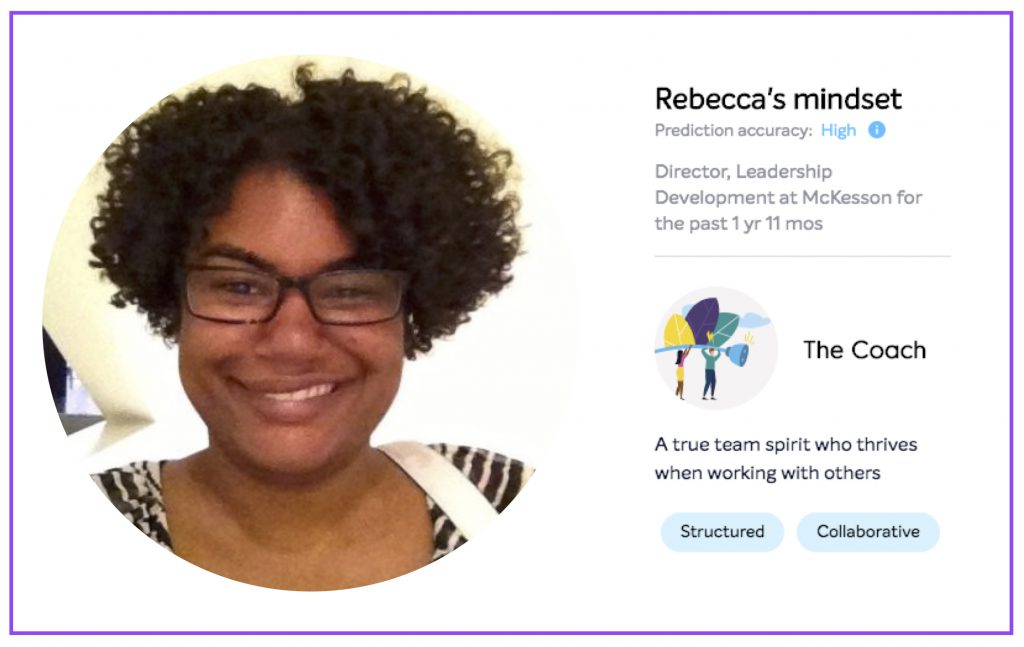In this edition, CULTURED had the pleasure to talk with Rebecca R. Cañate, Director for Leadership Development at McKesson, about team culture and what technology and data can offer to HRBPs and HR managers in general.
Apart from sharing her career path with us, Rebecca reflected on the difficulties of shifting focus from executing to managing, having the right data in HR to make revenue based decisions, and how to coach managers in the right way.

CULTURED: Hey Rebecca, what kind of projects do you work on, typically? Help us understand the concept of McKesson as well. What’s the stage that you guys are at and what’s the context that you’re working in?
I work at McKesson – we are a global leader in healthcare supply chain management solutions, retail pharmacy, healthcare technology, community oncology, and specialty care. McKesson partners with life sciences companies, manufacturers, providers, pharmacies, governments, and other healthcare organizations to help provide the right medicines, medical products, and healthcare services to the right patients at the right time, safely and cost-effectively.
We are highly dispersed and we deal with a range of employees: in the US and Canada, we are about 30,000 workers. We have another 35,000 in Europe. However, the model is a little bit different in the latter because we actually own retail pharmacies there. The businesses look different because the US separates retail pharmacies from the distribution aspect.
I started about 18 months ago and was brought specifically to help figure out what our L&D strategy should be and to build content for that. They were redesigning all of it because they had lovely classes that people attended but then did nothing about. The classes were from best-in-class vendors like Franklin Covey, “Crucial Conversations” from VitalSmarts, and stuff that you’ve definitely heard of. However, these skills were not necessarily tied to where the business was nor where it needed to go.
Wonder how your team is doing?
Find out with Bunch.ai in real-time!
With that being said, they wanted us to build something that was internal and that also helped to build capabilities for the future.
I work on a broader talent management aspect: My boss is the head of Leadership Development; my peers are in charge of talent programs, DI, workforce planning & analytics. I like to view what I do as a marketing arm of talent management. We’re taking the older things that our employee opinion surveys say, or what our new performance management system says, then we identify potential challenges, and we teach our managers in a practical and applicable way how to work on the team culture.
CULTURED: How did you close the gap between planning for the future and actually finding the means to get there?
The really nice thing about where I landed was that the company had already decided what they needed to work on for the future because we know that we had a lot of threats to our business.
We knew that we needed to change from a slower company that took advantage of the fact that we had solid revenue: now with the new threats, we need to focus more on our people because that’s basically our biggest advantage. We aren’t a production company, we are in logistics and it’s our people who do that, so team culture is essential.
CULTURED: When you look back on late 2018 and early 2019, what were the challenges from a professional perspective that were hard for you to overcome? How did you approach them?
This is my first time being a people manager. It takes a while to reach the point when you actually get to manage somebody in HR. It’s a little humbling to examine what you’ve been telling people, only to find that, when it’s time to lead a team, it can be hard to follow your own teachings. I think this is the part where you’re getting a little taste of your own medicine and hopefully makes you design better courses because you have practical knowledge of how hard leading a team can be.
I have one person in my team currently, and also have a few rotations in our HR program – so far two team members. As a result, in a short period of time, I’ve had a lot of different types of management situations and practice. Which I think makes m a better professional in L&D and a better people leader.
CULTURED: If you have a conversation with someone who is just starting and growing their business with a millennial workforce, and would want to make L&D the core of their business, what would be your advice from your perspective?
My job before this was at a 500-person startup where I was a combo HRBP while also running L&D. Through that experience, I learned some important things:
I learned that you need to have good managers because, in startups, they are the ones who have contact with most people; they have the most conversations and are the ones who are filtering through the things that you’re saying in order to realize the actual work experience and team culture. If they’re bad, then people will start to think that your company sucks after a while. So I think one of the most important things is teaching your people how to be good managers; help them with that mindset shift so that they can be really good at thinking about development opportunities and engaging with resources.
To support their efforts at the previous company I worked at, we used Slack to start conversations and share resources about team culture. We were also small enough so that I, as HRBP, could sit down and chat with the managers about how to be better. I tried to engage those who were recently promoted to people leaders and tried to talk them through the mindset shift from doing to managing. So I focused a lot on individual coaching in a wide variety of areas.
CULTURED: Considering the importance of the advisor-manager relationship, how do you know what to recommend to your managers? How can you make sure that your advice will land well with them?
The most important thing is that you understand how your company makes money and how that person, the manager, is trying to make money.
This means knowing what roles on their team are critical to the company versus what we have more flexibility on. So in the past when I knew there was one single person filling a role managing the tech for our customer service platform, we needed to plan ahead and have talent pipeline in case that person decided to leave. That was a role the people leader could not afford to have empty, and I could make a business case for why focusing on that role was important.
I’m not always successful – managers are busy and they are human. So I also make sure that when things go wrong, that I am responsive and partner to solve the problem quickly. I also try to make those teaching moments and tie them to how we can avoid panic in the future.
Measure company culture without surveys!
Get insights about your team’s morale based on data from Slack
CULTURED: When it comes to people analytics and HR technology, what currently excites you about the technological developments in this field, and what currently worries you?
I think the most interesting thing about HR tech is that we finally have the data we need to make revenue-based decisions. Nowadays, I can look at my data and immediately know how long people stay in their roles. In this sense, I can predict exactly when I need to start talking to these individuals because they might receive other enticing offers from other employers.
I can also look at communities of practice (CoP) in better ways now. I think that the more systems that allow you to combine data, instead of you having to make the connections manually, the better decisions you’ll be able to make.
However, the one thing that worries me is that we might be losing the human part. Most companies at the moment are really invested in the hiring process: I think the major problem in this area is that the managers never really define what they need in the first place. In this sense, the amount of technology that you use isn’t really relevant if you don’t know what you’re looking for. So they dismiss candidates due to unrelated factors when they could actually have the potential for the job. I think data and tech can help, but our biases are stronger than all of them unless we are clear about our hiring goals.
CULTURED: What unpopular opinions about HR do you hold?
I think HR is getting overly-invested in the peripheral of things that we can offer rather than in the core: knowing your talent and how to make them better workers. With that said, we tend to focus on bonus stuff like the fertility benefits, for example, or pet insurance. I have a dog, so I’m excited by the prospect of pet insurance, but while these aspects are definitely relevant and provide value to the employees, they don’t keep employees if we don’t provide them with meaningful work, feedback and growth opportunities. To me, this means we should know our talent the best and that we should know how to influence our managers so that they make the best talent decisions.
Nurturing talent and building a team culture are the center of all things. However, we tend to lose sight of the goal and ultimately decide to focus on these peripherals to keep the employees happy on a surface level.
CULTURED: Thanks a lot for your time and insights, Rebecca!
—
Thanks for checking out our Expert Series! We publish new interviews regularly with People leaders from Fortune 500 companies, hyper-growth startups, and everything in-between. To stay in the loop, subscribe to our email newsletter here: Beyond the obvious: Hacks for high-performance leaders and teams.





